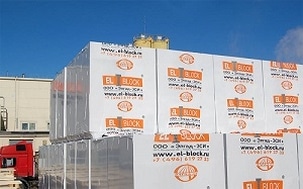Calculator
Aerated concrete blocks
8 advantages of foam concrete over other materials
-

A construction crane is not needed to lift blocks of foam concrete, which simplifies the work of builders. You can also save a lot on the foundation, since the walls will be much lighter than brick walls.
-

More conventional bricks – construction goes faster as less laying time
and lower mortar costs. -

In terms of thermal conductivity, foam concrete is not inferior to wood – a 40 cm wall is able to withstand -30° frost.
-

Foam concrete withstands one-sided exposure to fire for at least 3 hours, on average – 5 hours.
-

High energy-saving properties allow residents to significantly save on heating.
-

The cellular structure is at least 10 times higher than that of brickwork, the room is very quiet.
-

Does not emit toxic substances, does not rot or age, which ensures the safety of residents.
-

The price for all these benefits is also attractive! Of all the materials for building walls, in terms of the ratio “price/quality”, foam concrete has no equal.
Characteristics and properties of foam concrete
Reliability
Lightweight concrete is an almost ageless and almost eternal material. It is not affected by time, does not rot, has the strength of a stone. Increased compressive strength allows the use in the construction of products with a lower volumetric weight. This further increases the thermal resistance of the wall.
Warmly
Due to the high thermal resistance, buildings made of foam blocks are able to accumulate heat. That during operation can reduce heating costs by 20-30%.
Microclimate
Foam concrete prevents significant heat loss in winter, is not afraid of dampness, and avoids too high temperatures in summer. Regulates the air humidity in the room by absorbing and releasing moisture, thereby contributing to the creation of a favorable microclimate (Microclimate of a wooden house).
Fast masonry
The low density, and, consequently, the lightness of concrete, the large dimensions of the blocks compared to bricks, make it possible to increase the laying speed by several times. Easy to process and finish – cut channels and holes for electrical wiring, sockets, pipes. Ease of masonry is achieved by high accuracy of linear dimensions, the tolerance is +/- 1 mm.
Soundproofing
Cellular concrete has a relatively high sound absorption capacity. In foam block houses, current soundproofing requirements are met.
Economy
The high geometric accuracy of the dimensions of the products allows laying blocks on glue, avoiding “cold bridges” in the wall and significantly reducing the thickness of the internal and external plaster. The weight of foam concrete is less from 10% to 87% compared to standard heavy concrete. Significant weight reduction results in significant savings on foundations.
Beauty
Thanks to good workability, it is possible to produce various shapes of corners, arches, pyramids, which will add beauty and architectural expressiveness to your home.
Fire safety
Foam blocks reliably protect against the spread of fire and correspond to the first degree of fire resistance, which is confirmed by the relevant tests. Thus, they are well suited for applications in fire-resistant structures. When exposed to intense heat, such as a blowtorch, on the surface of foam concrete, it does not split and does not explode, as is the case with heavy concrete. As a result, the fittings are protected from heating for a longer time. Tests show that 150 mm thick blocks protect against fire for 4 hours.
Environmental friendliness
During operation, toxic substances are not emitted and, in terms of environmental friendliness, is second only to wood. For comparison: the coefficient of environmental friendliness of cellular concrete – 2; tree – 1; brick – 10; expanded clay blocks – 20.
Convenient delivery
A favorable ratio of weight, volume and packaging makes all building structures convenient for transportation, and allows full use of the capacities of both automobile and railway transport.
Breadth of application
Heat and sound insulation of roofs, floors, pipe insulation, production of prefabricated blocks and laying partitions in buildings. As well as from foam concrete of a higher density, the construction of interfloor ceilings and foundations.
Wide range of obtained densities
Depending on the purpose of concrete products and their operating conditions, it is possible to manufacture blocks with a density of: from 400 to 600 kg/m3 to obtain heat-insulating blocks; from 700 to 1100 kg/m3 for the production of thermal insulation and structural products (foam blocks, slabs, lintels); from 1200 to 1600 kg/m3 to obtain structural foam concrete blocks.
Foam blocks or gas blocks?
Foam concrete blocks have the following properties:
– Strength
– Lightweight
– Low thermal conductivity
– High frost resistance
Thanks to the listed properties, foam concrete competes with another cellular material – autoclaved aerated concrete. On the one hand, their characteristics are similar. But with a detailed study of the properties of these materials, we can safely say that fiber foam concrete is superior to aerated concrete in several ways. It has a closed pore structure, that is, the bubbles inside the material are isolated from each other (unlike aerated concrete).
Foam concrete practically does not absorb moisture, unlike aerated concrete, which has through pores. Taking samples of blocks of the same density, placing them in a container with water, you can see for yourself the difference in the properties of these materials. The foam block floats on the surface of the water, and the aerated concrete sinks. Accordingly, fiber foam concrete blocks have higher heat-shielding and frost-resistant characteristics. They can be used in places of high humidity, where the use of aerated concrete building materials is unacceptable due to its high water absorption.
The plasticity of foam concrete allows the use of a cellular mixture for monolithic pouring, in cases where it is not possible to use block heat-insulating materials, unlike aerated concrete. Roofing made of foam concrete, even with damaged waterproofing, retains its thermal insulation properties, which cannot be said about aerated concrete. Also, the advantage is the ability to create a heat insulator with a density of 250-300 kg/m3 directly on the construction site.
Aerated concrete with a density of less than 400 kg/m3 is much more difficult to deliver to the site. Aerated concrete requires subsequent processing: plastering, priming and moisture-proof painting, which is not required for monolithic foam concrete. In winter, moisture that gets into aerated concrete freezes and destroys the structure of the material, the strength characteristics of the surface layer and plaster are weakened.


